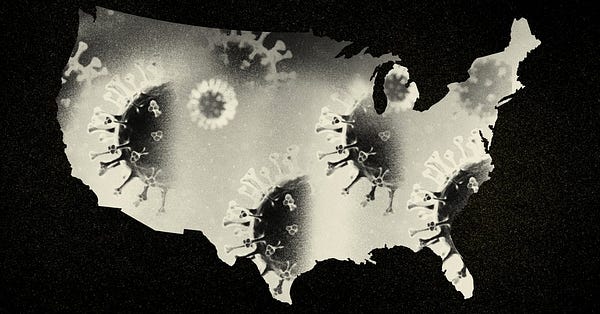COVID-19 day 121 : 📈 1,551,853 cases; 93,439 deaths : 20 May 2020
Global cases (tested) crossed the 5 million mark; repeat after me, the US has 4% of the world's population and 31% of known cases of COVID-19, and that is not because we've tested a lot of people

It’s day 121 since the first case of coronavirus disease was announced in the United States. Given the framing coming out of DC, we need to constantly remind Americans that we have a statistically non-representative percentage of COVID-19 cases and deaths worldwide.
The U.S. has only 4% of the world’s population. It has 31% of global COVID-19 known cases (1.6 million) and 28% of known deaths (93,439).
One month ago, we had 32% of known cases and 23% of known deaths.
Why do we have more cases of coronavirus relative to our rank in global population?
In part it’s when the virus arrived here. But it is also because we were so very very late to try to identify those who were infected, which made tracing contacts and quarantine impossible. From 13 March:
Despite the fact that last week, Vice President Mike Pence promised that “roughly 1.5 million tests” would soon be available, an ongoing Atlantic investigation can confirm only that 13,953 tests have been conducted nationally. New York, which has shut down Broadway and has at least 328 coronavirus cases, is still failing to test patients who have worrying symptoms. As late as March 6, a busy clinic in Brownsville, Texas, a border city of nearly 200,000 whose population crosses back and forth from Mexico frequently, told me they could test only three people. By comparison, South Korea, which has one of the largest outbreaks outside China, is testing nearly 20,000 people a day.
This interactive chart shows the growth in tested cases from 21 January 2020 (the first publicly known case in the US and South Korea) to today. Note that New York has slightly less than half the population of South Korea; Washington, 15%.

President Trump can (and does) repeat a variation of this lie ad nauseam — “We have more cases than anybody in the world. But why? Because we do more testing.” — but repetition does not make it so.
Our positive case rate is not an artifact of how many tests we conduct. It’s an artifact of testing (mostly) people with symptoms.
In other words, tests reveal disease. They don’t cause disease.
Here’s how we stack up against a few other countries (today’s data) in tests per million population:
Spain and Portugal: 65
Belgium: 62
Qatar: 58
Russia and Italy: 51
UK: 41
Switzerland and Belarus: 40
USA: 38
Moreover, as Robinson Meyer and Alexis Madrigal wrote in The Atlantic on Sunday, there are “major discrepancies between what many states are reporting and what the federal government is reporting about them.” So CDC testing data, which are delivered via Vice President Pence, must be viewed with some skepticism.
Like Texas (reported yesterday), Georgia and Pennsylvania, the CDC is “is conflating” results from two very different tests - viral and antibody - in its gross daily testing report.
This is not merely a technical error. States have set quantitative guidelines for reopening their economies based on these flawed data points.
Robust testing, combined with declining positive cases, is a significant part of the guidelines for loosening stay-at-home orders. Trump’s disinformation confuses citizens (because news organizations repeat claims without context and nefarious actors amplify the quotes to grind their own axes) and is part of his “flooding the zone with 💩.”
🦠Wednesday, Johns Hopkins reported 1,551,853 (1,528,566) cases and 93,439 (91,921) deaths in the US, an increase of 1.52% and 1.65%, respectively, since Tuesday. A week ago, the daily numbers increased by 1.52% and 2.12%, respectively.
The seven-day average: 23,015 ⬆️(22,657) cases and 1,329 ⬇️ (1,350) deaths
Percent of cases leading to death: 6.02% (6.01%).
Today’s case rate is 468.83 per 100,000; the death rate, 28.23 per 100,000.
One week ago, the case rate was 420.16 per 100,000; the death rate, 25.42 per 100,000.
Note: numbers in (.) are from the prior day and are provided for context. I include the seven-day average because dailies vary so much in the course of a week, particularly over a weekend.
🤓 Recommended reading
Yesterday, I painted a future of “whack-a-mole” as Americans venture out into crowds and groups. Today, perhaps the most insightful writer on COVID-19 elaborates on that theme.
If you read only one article this week, read this. You might want to print it; it’s long and cries out for side notes and review.


The virus isn’t lying in a bush, waiting to pounce on those who reemerge from their house. It is, instead, lying within people. Its ability to jump between hosts depends on proximity, density, and mobility, and on people once again meeting, gathering, and moving. And people are: In the first week of May, 25 million more Americans ventured out of their home on any given day than over the prior six weeks…
The measures that most successfully contain the virus—testing people, tracing any contacts they might have infected, isolating them from others—all depend on “how engaged and invested the population is,” says Justin Lessler, an epidemiologist at Johns Hopkins. “If you have all the resources in the world and an antagonistic relationship with the people, you’ll fail.”
This is why I avoid TV news:


🔬 Research and medical news
Of 1,150 COVID-19 adult patients hospitalized in New York City from Mar 2 to Apr 1, 257 (22%) were critically ill, and 101 (39%) of them died, according to the largest known US prospective study of coronavirus patients.
In the prospective cohort study, published yesterday in The Lancet, researchers from Columbia University and two affiliated NewYork-Presbyterian Hospitals in Manhattan reviewed electronic medical records and lab and radiographic findings of COVID-19 patients in respiratory failure.
Critical illness common in New York COVID-19 inpatients: study, CIDRAP News, 20 May 2020.
🧰 It’s referenced right and left, but can you explain it? Coronavirus: What is the R number and how is it calculated? BBC News, 18 May 2020.
❌ I do not know Stanford researcher John Ioannidis except for his inane take on COVID-19 (a STAT News op-ed) and his involvement with the methodologically-flawed Santa Clara County CA antibody study. Because of his reputation, expect to hear more about his latest, strike three.


Sections (no jump links, sorry!)
1, Around the country; 2, Around the world; 3, Case count; 4, What you can do and resources
⓵ Around the country
America has returned to normal.


⓶ Around the world
✅ Wuhan, China has banned eating, hunting or breeding wild animals for five years. The rules “also bar the consumption of rare and endangered aquatic animals.”
❌ Brazil reported 19,694 new cases today; that is a 19.2% increase over Monday. Tuesday’s total of 291,579 cases is significantly larger than the seven-day cumulative average, 245,268.
“I can categorically say that Brazil has become the most important epicentre for the spread of the Covid-19 virus in the world,” Domingos Alves, a professor at the Ribeirao Preto Medical School told BBC News Brasil.
President Bolsonaro is a COVID-19-denier according to the BBC:
The far-right leader has been attending anti-lockdown demonstrations, shaking hands with supporters, and even promising to hold a barbecue “for about 30 guests” in the middle of the pandemic…
In March, Twitter and Facebook deleted presidential posts after identifying them as fake news.
▪️ Excerpt/composite. I was struck by the 5 million. And I’ve been wanting to experiment with the built-in chart.

Please take a moment and answer this short reader survey! ✅
⓷ Case count
There is a lag between being contagious and showing symptoms, between having a test and getting its results. The virus was not created in a lab and the weight of evidence is it was not released intentionally. Although early reports tied the outbreak to a seafood (“wet”) market in Wuhan, China, analyses of genomic data in January suggested that the virus might have developed elsewhere.
🌎 20 May
Globally: 4 789 205 cases (57 804 - new ) with 318 789 deaths (2 621 - new )
The Americas: 2 105 670 cases (22 782 - new ) with 125 843 deaths (1 176 - new )
Johns Hopkins interactive dashboard (11.00 pm Pacific)
Global confirmed: 5,000,561 (4,900,356 - yesterday)
Total deaths: 328,191 (323,345 - yesterday)
Recovered: 1,899,675 (1,689,377 - yesterday)
🇺🇸 20 May
CDC: 1,528,235 (23,405 new) cases and 91,664 (1,324 new) deaths
Johns Hopkins*: 1,551,853 (1,528,566) cases and 93,439 (91,921) deaths
State data*: 1,542,309 (1,520,778) identified cases and 87,472 (86,070) deaths
Total tested (US, Johns Hopkins): 12,647,791 (12,233,987)
View infographic and data online: total cases and cases and deaths/100,000.
* Johns Hopkins data, ~11.00 pm Pacific.
State data include DC, Guam, the Northern Mariana Islands, Puerto Rico and the US Virgin Islands
⓸ What you can do
Stay home as much as possible, period.
Digestive problems may be a symptom.
Resources
👓 See COVID-19 resource collection at WiredPen.
📝 Subscribe to Kathy’s COVID-19 Memo :: COVID-19 Memo archives
🦠 COVID-19 @ WiredPen.com
🌐 Global news
📊 Visualizations: US, World



